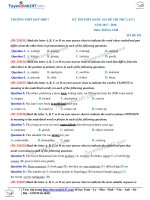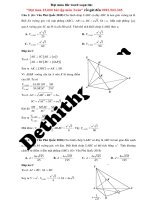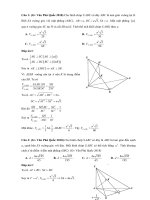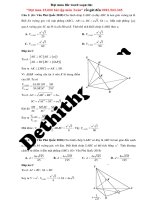Cs224W 2018 56
Bạn đang xem bản rút gọn của tài liệu. Xem và tải ngay bản đầy đủ của tài liệu tại đây (6.27 MB, 8 trang )
Popularity Growth Analysis and Prediction on Yelp
Yilong Li, Zehui Wang, Zhouchangwan Yu
Stanford University, Stanford CA 94305
{yilong,
wzehui,
Abstract—Research on the spread of information has been
gaining popularity in recent years but most of the research has
focused on social media platforms like Twitter and Facebook. In
this project, we analyze the cascading behavior on Yelp, with a
focus on how business gets popular. We analyze the relationship
between business and users and how information distribution
within user social networks influences the popularity of the
business. Based on the analysis we then use GraphSAGE [6]
framework to train embeddings for each business based on its
cascading graph to predict its popularity.
I.
INTRODUCTION
RELATED
WORK
A. Measuring User Influence in Twitter: The Million Follower
Fallacy [1]
In this article Cha et al. discuss about the characteristics of
influential” users in social networks like Twitter. In Twitter
the authors use three metrics to measure the influence of a certain user: indegree (number
of his posts) and mentions
of followers), retweets (retweets
(replies to his tweets). And the
authors reach the following conclusions:
(1) By analyzing the top influentials
measures,
and
measuring
the
correlation
(2) From the spatial (topics) perspective, by analyzing the
distribution and correlation for the metrics on tweets about
different news topics, the authors find that for top influentials,
there are more correlations over different topics, i.e. top
influentials usually can have significant influence over a variety
of topics, and the influence of users on different topics all
follows the power-law trend.
(3) From the temporal perspective, the authors analyze
the dynamics of influence over time. Different groups —
top news agencies and celebrities — have different temporal
characteristics
Social media has become an important source of information about a wide variety of businesses, and people have
become more dependent on the information from social media
when making consumer decisions. Social review websites
such as Yelp serve as platforms for people to exchange their
opinions about the businesses through reviews, ratings, photos,
etc. Understanding the popularity growth based on the network
between businesses and consumers is of great importance
for business owners and platform service providers to make
business and marketing strategies. In this project, we analyze
the how user behaviors influence the popularity of businesses
and make predictions based on the features extracted from our
analysis. Specifically, we would like to analyze how business
gets popular on Yelp and make predictions from its users.
We divide the work into two parts: graph analysis and
popularity prediction. The goal of analysis is to find how a
business gets popular - whether it grows gradually or explodes
at a certain time period and how user behavior will influence
the popularity of the business. Then we do prediction based on
features that are extracted from the conclusion of our analysis
1
II.
zyu21}@stanford.edu
across
these
between
three
different
metrics for different groups, the authors find that the correlation between indegree and other metrics are quite weak, i.e. the
most-followed person are not necessarily the most influential.
'The link to our code: />
for both retweets
and mentions:
For retweets,
all groups have small increases of retweets over time, while
for mentions which requires more interaction between twitter
users and the ’influentials”, we can see a large decrease for top
accounts (news accounts) and a large increase for the top 100-
200 users which requires more self-advertisement and thus has
more involvement with users.
B.
Cascading Behavior in Yelp Reviews [2]
Khan et al. analyzed cascading behavior within Yelp user
social network. Their work can be divided to two parts:
structural analysis of cascades and cascade growth prediction.
In structural analysis, they summarize some frequent cascade topologies. The most common cascade topology corresponds to the case where a person participates in a cascade
under the influence of only one other node. While this particular type of cascade represents more than fifty percent of the
cascades across all the cities, statistics show that receiving the
influence from more than one friends increases the likelihood
of participation of the cascades.
Before the experiment of predicting cascade growth, they
categorized the cascades as long or short cascades: If the
length of a cascade is greater than or equal to the 90th percentile of the length of all the cascades of the city, then this is a
long cascade; similarly a short cascade has a length that is less
than the 90th percentile. Then the problem of cascade growth
prediction is a supervised classification problem: predicting
whether one cascade is long or short. They gathered features
including root features (features of the original node who
started the cascade),
non-root features, business
features and
adopted gradient boosting as the learner. The results showed
that the first reviewer may not be that importance in the case
of cascades in Yelp reviews or in other words, non influential
nodes may start the cascades.
C.
The Tube over Time: Characterizing Popularity Growth of
YouTube
Videos [3]
Figueiredo et al. characterize the growth patterns video
popularity on YouTube, the most popular video sharing ap-
plication. The two goals of their analysis are to understand
(1) how the popularity of individual videos evolves over time
since the video is uploaded (2) how users reached a given
video by different types of referrers.
The authors collected data from YouTube statistics and
divide into three datasets: (1) popular videos on top lists
maintained by YouTube
(Top);
(2) videos that were removed
due to copyright violation (YouTomb);
videos
(3) random
sampled
(Random)
To understand the popularity growth patterns, the authors
performed analysis on the each dataset based on two aspects:
(1)
the
time
interval
until
the
video
reached
most
of
its
popularity (2) the burst of popularity experience by a video
in days or weeks. They also further analyze the temporal
dynamics of videos experience bursts activity by categorizing
into
Viral
videos,
Quality
videos,
and
Junk
videos.
For
category.
The authors conclude that the popularity growth pattern
depends on the video dataset. The Top videos experience
sudden bursts, while the copyright-protected videos experience
a viral epidemic-like propagation. For all three datasets, search
and YouTube internal mechanics are two most important
referral mechanisms.
Critique
1) Measuring User Influence in Twitter: The Million Follower Fallacy [1]: In this article, by analyzing three common
metrics
of Twitter
users,
the authors
ate the users’
popularity,
which
followers,
the users’
influence
and
successfully
is measured
over
differenti-
by number
the network,
of
which
is more measured by retweets and mentions. The network is
easy to acquire and the methods are all very straightforward —
they focus on some top users and make statistics about their
behaviors. There are also some deficiencies for this article:
For the topic related characteristics, it lacks some categorized
information, i.e. is there any difference in topics the top
influents focus on by user categories, since news media will
have a much larger topic correlation factors than celebrities
and other user-generated contents creators. Also the number
of topics they research on is too small — they only have
three topics while the timeline of a celebrity can be more
complicated. For future work, since the temporal increase of
users’ mention influence for the emerging influential users is
very clear, and we can use similar metrics within a fixed time
window to predict new influential users in the future.
2) Cascading Behavior in Yelp Reviews [2]: This paper
focuses on the cascading behavior among user social network
in Yelp. The author analyzed the structural characteristics
of cascades and predict how cascades will grow. Previously
most of the research on cascades behavior focused on social
platforms like Twitter, while this paper extend the research to
Yelp and its user networks. The novel idea is that the authors
define cascading behavior based on temporal information and
user networks. They assume that the information of a particular
social network, 1.e., only two
users are friends will the information be cascaded.
However,
the mechanism of Yelp allows people to watch reviews of
a business that are written by anyone, which means that
information can be distributed without social networks.
3) The Tube over Time: Characterizing Popularity Growth
of YouTube Videos [3]: This paper provides several metrics to
characterize the popularity growth patterns of YouTube videos
and the referral mechanism of them. One of the weakness of
this paper is the method that the authors use to characterize
the temporal dynamics of videos. They categorize videos into
viral, quality, or junk videos, which is based on the fraction of
views received on the most popular day. A more solid metrics
is needed for the long-range popularity evolutionary patterns.
the
referral mechanism, the authors identified 14 types of referrals.
For each dataset, they study the fraction of views from each
category and the wait time until the fist access from each
D.
business flows through users’
III.
A.
APPROACH
Dataset
Here we use Yelp Dataset Challenge [4] Round 12 in our
project. It includes information about local businesses in 10
metropolitan areas across 2 countries.
For each business, we get all its basic information including
business
categories
(restaurant,
health
care,
cleaning,
etc.),
location (city, postal code, longitude and latitude) as well as its
all review information, including the date, stars, text contents
and the reviewer information for each entry, thus it will be
possible to calculate current stars and ranking of a business at
a certain time period.
B. Data Analysis
We
analyze the dataset from three aspects: cascading be-
havior, business information and user-user network.
a) Cascading behavior: To understand how a business
gets popular, we start with analyzing its cascading network.
We first define that an edge (u,v) will be apart of a cascade
for a business b if the user u writes a review or tip at time ¢
and user v writes a review or tip at time t’ such that wu is the
neighboring node of v and ¢’ > t. Then for each business, we
can generate its cascading graph and analyze its properties.
b) Business information: The goal of this part is understand the properties of the businesses on Yelp so that we
can generalize a good metric to measure their popularity. We
analyze business information from these aspects: locations, reviews (scores and rankings), spatial distribution, and temporal
properties. Finally, based on our analysis we define a score to
measure the popularity of each business.
c)
User-user network:
Since the cascades
of a business
depend on user’s social network, we need to fully understand
the user-user network on Yelp. We analyze its degree distributions, clustering coefficient and average ratings. We also
analyze the differences between elite users and non-elite users
in the network.
C.
Prediction Model
After analyzing the properties of business, user network
and cascading behaviors, we leverage the results we find to
predict the popularity of a business. Based on our analysis
on user-user network, we generalize features for each user,
i.e., their network degrees, whether they are elite users etc., as
described in Section IV-C. In Section IV-A we also constructed
cascading graph for each business. Then we adopt GraphSAGE
[6],
an
inductive
framework
that
leverage
node
features
Algorithm
Node
Embedding
Graph
Embedding
MLP
Regressor
generation algorithm. Adapted
[6]
Data: Graph G(V, £); node features {x,,Vu € V};
depth K; weight matrices W*, Vk € {1,..., K};
to
non-linearity a; differentialbe aggregator functions
generate node embeddings for unseen data. This framework
learns a function that generates embeddings by aggregating
information from a node’s local neighborhood. After generating embeddings of each node, we obtain the embeddings of
the whole graph of the business by averaging all the individual
node embeddings.
Cascading
Graph
1: Embedding
from GraphSAGE
Agg,Vk € {1,..., K}; neighborhood function
N:u¬9w
Result: Vector representations z, for all
€ V
hộ — z„,Vu € V
for k = 1,...,K do
for v € V do
hạ) — Agge {hk Wu € N(w)})
Popularity
Score
hE — o(W* -CONCAT(hE-}, hy (e)))
hk & WS /|[hk|l2,Vu € V
By
ry AY
|
| Non
Iq
i
À
©
Y
|
|
Fig. 1: Overview of the prediction model
The algorithm is described in Algorithm 1. We first initialize
node embeddings to be input node features. Then at each
iteration, nodes aggregate the embeddings of their neighbors
and are combined with their previous embeddings. Finally, the
combined embeddings are fed through a dense neural network
layer and repeat the process. For simplicity, the aggregator
function we use is the mean operation, where we take the
elementwise mean of the vectors in {hk—-!,
Vu € N(v)}.
hE Wu
EV
small with maximum length for most cities below 10. The
majority of business do not have cascades or have very short
cascades but long cascades do happen. This can be explained
by user-user network analysis later in Section IV-C, which
shows that the node degree in user social network follows a
heavily tailed distribution with the majority of users on Yelp
have very small node degree. Fig.2 shows the distribution of
the size of cascades in some large cities. The patterns follow a
power-law distribution. Fig.3 shows some examples of review
cascades of business across different cities. For each city we
pick the business which has the longest cascading length. From
Fig.3 we can see that some users have strong influence and
spread the information to many other users.
After that we sum up the embeddings of each node to obtain
graph embeddings, and then regress on the popularity as we
defined in Section IV-B4 temporal analysis. We will use mean
squared error as loss defined as
Loss = So (yi — 4)?
where y; is the ground truth and ?; is the prediction result.
We use a multi-layer perceptron model as our regressor [7] .
Fig. 1 displays the pipeline of our prediction model.
We
will
use
R-squared
(R?)
to
evaluate
our
(a)
(b)
(c)
(d)
regression
results. It provides a measure of how well observed outcomes
are replicated by the model. Suppose our dataset has n values,
then the ground truth popularity is denoted as y = [y1,..., Yn],
with predicted values 7 = [f1,..., Gn]. Let y be the mean of
the data, then R? is
R?=1—
View
=l1—
=
Viot
IV.
A.
DATA ANALYSIS
3); (yi — 9)
RESULTS
Fig. 2: Distributions of the size of cascades across different
cities. X-axis shows the number of nodes that participate in
the cascades. Y-axis is the number of business that has the
corresponding size.
Cascading Analysis
We first analyze the
in different cities. We
the longest path from
here, to any leaf node.
distributions of the length of cascades
define the length of a cascade to be
the center node, which is the business
We find that most of the cascades are
B.
Businesses
1)
Cities:
and 5996996
In our dataset, there are totally 188593 businesses
reviews. The data was collected in mainly
10
|
%
200
°
Nu
Frequency
=
w
=
ư
So
©
°
Number of reviews
0.4
Business score
Review score
0.1
0.0
Fig. 3: Examples of review cascading of business. Green
nodes represent users. Red nodes represent the business and
its econet represents the users that start the cascading.
3
2
3
Stars
4
5
Fig. 5: Distribution of business score and user review scores
Top cities with most reviews / business
Las Vegas
0.81
Phoenix
Toronto
0.73
Charlotte
Scottsdale
Calgary
Pittsburgh
0.64
0.54
0.45
0.34
0.24
—
—
0
10
20
Mesa
Cumulative # of businesses
Cumulative # of reviews
30
40
105
4
104
4
Fig. 4: (a) Cumulative number of businesses and reviews of
50
Fig. 6: Review
distribution
in US
and
Canada,
and most
100
150
Number
the top cities (b) Ten top cities
areas
star(s)
star(s)
star(s)
star(s)
star(s)
Montreal
Henderson
(b)
50
(a)
metropolitan
1
2
3
4
5
Number of businesses
0.94
200
250
300
of reviews
count for businesses
follows the power-law
of the data
was around the center cities, including Las Vegas, Phoenix,
Toronto, Charlotte, Calgary and Pittsburgh. About 76% of
reviews and 62% of the businesses belong to these top cities, as
shown in Figure 4, so in future analysis of business popularity,
we will mainly focus on these cities.
2) Reviews, scores and rankings: For each review a user
gives to a business, it contains a rating score ranged from
completely different. We can plot the distribution of businesses
with different numbers of neighbors within a certain radius, as
shown in Figure 7 — Here we can see that businesses in most
cities are scattered or they form into small clusters with less
than 150 nodes inside it (e.g. Las Vegas and Phoenix); there
are also cities whose business district are more connected and
1 to 5 and
more close to each other, like Montreal.
an optional
comment
message,
and
the score
of
the business is just the average of all the rating scores it
receives. The distribution of businesses and distribution of
reviews grouped by their scores is shown in Figure 5. Here
we can clearly see that, users tend to give 4 or 5 stars in most
cases, and most of the businesses
are rated as 3 to 4.5 stars.
Note that most 5-star businesses have only a few comments,
usually less than 20, and we filter these businesses out for our
analysis. If we look into the statistics of reviews counts, we
can find that the review counts for businesses generally follow
the power-law
3) Spatial
and
different
distribution, as shown
distribution:
Since
layouts,
distribution
the
in Figure 6.
cities have
different
of businesses
sizes
can
be
In order to look into the closeness of popular businesses, for
the top-rated and most-reviewed businesses, we dynamically
create a network of businesses based on the relative distance
between nodes. We choose businesses with review counts or
score greater than a given value as nodes of the network, and
then add edges between nodes within a certain radius and
evaluate the clustering coefficient as the radius increases. Here
we take Las Vegas as an example. We can see that for all
valid businesses the clustering coefficient reaches its maximum
value at about 800 metres; for businesses with more than 100
and 200 reviews, the maximum value is reached at 1000 and
1200 meters respectively. Top businesses are mostly scattered
Distribution of # of businesses within 0.5 mile
Phoenix
Las Vegas
0.050
0.05
0.05
0.025
0.000
0
200
400
600
Charlotte
0.00
0
100
200
300
Scottsdale
0.075
0.10
100
200
300
0,000
0
200
Pittsburgh
0
100
200
0.00
400
600
50
100
150
200
Montréal
0
100
200
300
400
500
Week after first review
600
70C
0
(a) Top 200 business
0.04
0.02
0.00
0
0.06
0.04
0.05
200
Calgary
00
400
Mesa
616
0
01
0.025
0
0.00
02
0.050
005
0.00
Toronto
0.10
3-F
0.075
100
200
300
400
Week after first review
500
600
70C
(b) Top 1000 business
100
0.02
0
20
40
60
80
0.00
0
100
200
300
Fig. 7: Distribution of businesses with neighbors, horizontal
axis: number of neighbors in 0.5 mi, vertical axis: percentage
=|
——
——
——
10.0% of reviews
25.0% of reviews
50.0% of reviews
——
75.0% of reviews
——
Clustering Coefficient
0
100
200
300
400
Week after first review
90.0% of reviews
500
600
70C
°
a
(c) Top 5000 business
Fig. 9: Time taken for businesses to reach certain percentages
of reviews.
—*—Reviews
>20
—*—Reviews
> 100
Reviews > 200
0.4
0
500
1000
1500
horizontal
axis:
number
of weeks
taken,
vertical
axis: percentage of businesses which reached that percentages
of reviews
2000
Radius (m)
Fig. 8: Clustering coefficient of the spatial connection graph
businesses with more reviews, this time can be later. Possible
reason can be that it was recommended by some influential
users or influential social medias, and these businesses will be
what we focus on for future analysis stages.
rather than spatially connected closely.
4)
Temporal
analysis:
Similar
to the methods
in [3], we
can analyze the popularity (i.e. review count) growth patterns
in our dataset by measuring the following metrics: (1) the time
it takes for a business to get popular; (2) the time popularity
(number of reviews) burst happens. Here we take Las Vegas
as an example.
a) Time taken to get popular: For each business, we can
calculate how many weeks it takes for the business to reach
a certain percentage (e.g. 10%, 50%, and 75%) or a certain
number (e.g. 100, 200) of reviews, as shown in Figure 9.
We calculated the top 200, 1000 and 5000 rated businesses
in Las Vegas, and we plot the time it takes to reach certain
percentages of reviews. Unlike videos [3] or tweets [1] which
get their maximums very quickly over the Internet, the number
of reviews usually increase gradually and it becomes really
hard (usually takes about 8 to 10 years) to get most of its
current reviews. And we can clearly find that about 40%
of the businesses reach the first 10% and first 25% of their
reviews much faster than others, and this tendency holds for
all different business subsets.
b) Popularity bursts: Here for each business we find the
month with most reviews (“peak month”), of which the result
is shown in Figure 10, and we find that for most businesses
the peak month is on the first month after its opening — the
first month is critical for businesses to get most of its initial
reviews (usually 25 +20 reviews). And we also notice that for
C.
User-User Network
There are 1,518,169 user nodes
in which 67,109 are elite users,
in the user-user network,
and 879,891 users have
at least one friend on Yelp. As shown in Fig.11, both allusers and elite-users generally follow a power-law degree
distribution, P(k) ~ k~7. For elite users, y is much smaller
at low degrees and increases at high degrees. Fig.12 shows
the cumulative clustering coefficient of all-users and eliteusers. More than 70% users in the entire user group have
O clustering coefficient, and the cumulative fraction of user
increases rapidly as clustering coefficient increases. On the
other hand, only 10% in the elite user group have 0 clustering
coefficient,
and
the
cumulative
fraction
of
users
increases
slower.. The statistics of average degree and average clustering
coefficient is summarized in Table.I. Elite users tend to have
more friends and cluster more closely.
For both all-user group and elite-user group, the average
ratings of the users are shown in Fig.13. For the all-user
group, the majority of average ratings have medium values,
while there are two noticeable peaks at two ends, which means
that some users only express one of the extreme feelings on
Yelp review, i.e. 5 stars or 1 star. For the elite-user group, the
average ratings follows a normal
distribution with center at
4.0, which means that elite users tend to give more reasonable
ratings with various degrees of preference.
©
F
œ
oO
ef
10
(a) Top 500 business
20
30
40
Months
50
60
+>
oe
ction of node:
6
Months
£0.2
iret
70
0.0
(b) Top 2000 business
00
02
04
.
All users
+
Elite users
06
Clustering coefficient
08
10
Fig. 12: Cumulative clustering coefficient of all users and elite
users.
0
10
20
30
40
50
Months
60
70
80
10:
Distribution
horizontal
axis:
of the
month,
“peak
vertical
number
of businesses.
of businesses
which has peak month at this month
TABLE
All users
Elite users
Elite users
5 0.20
©
>0.15
2 0.10
ov
9 0.05
00
I: Statistics of all users and elite users
Average Degree
8.72
711.3
All users
@am
oe
month”
axis:
Mam
Ww
(c) Top 5000 business
Fig.
0.30
£0.25
1.0
1.5
2.0
2.5
3.0
Average
3.5
4.0
ratings
4.5
5.0
Average Clustering Coefficient
0.0431
0.172
Fig. 13: Distributions of average rating of all users and elite
users.
To understand the role of elite users, we randomly pick some
elite nodes and draw the egonets of them, as shown in Fig. 14.
We find that for the elite users with very large egonets, the
majority of the neighbors are elite users (red), and there are
many edges between neighbor elite users. Even for elite users
with smaller egonets, the neighbor elite users are more likely
to be connected than non-elite users (blue). This is consistent
with our analysis above that elite users have higher degree and
clustering coefficient. Elite users are more socially active in
the Yelp network.
10°
@ 104
5Š
2 103
{=
Thể
gu
- = All users
Elite users
`...
3
@ 102
E5
|]
574173
(b)
101
10°
=
101
Node
102
Degree
ome
.
103
Fig. 11: Degree distributions of all users and elite users.
(c)
Fig. 14: Example egonets of elite users. Purple node represents
the center elite user of the egonet. Red nodes represent
neighbor elite users. Blue nodes represent neighbor non-elite
users
V.
POPULARITY
PREDICTION
EXPERIMENT
A. Implementation Details
1.0
We run experiments on the Yelp dataset to predict the
popularity of a certain business.
For each business, we give one score to indicate its popularity. Since Yelp dataset only provides the number of reviews
and average stars provided for a single business, we define
the popularity of a business based on its relative ranking of
reviews in the given area, i.e.
Pl
business)
)
=
a
2.
prediction
a
>
# of businesses within 2 miles
cascading
II-C. The
the feature
knowledge
about
of friends,
total
0.213:
ranking of business within 2 miles
We first train the embedding of each business
graph using the approach described in Section
aggregator we use is mean operation. We initialize
vector of each node in the graph with our prior
the user:
0.8
counts
of reviews,
number
0.0
0.2
0.4
0.6
ground
0.8
1.0
truth
(a) Baseline
number of useful/funny/cool votes sent by the user, the number
of fans the user has, average stars, and the numbers of various
complement types received. The resulting embedding is a
vector of length 20 for each node. Then we take the mean of
all node embeddings, and the sum of all node embeddings to
get the graph embedding, which is the corresponding business
embedding we use as the input of our regression model. We
tried different regression models, including polynomial ridge
regression
(linear model),
multi-level decision tree and SVM
regression using radius-based Gaussian kernel. In our final
model we use a multi-layer perceptron, i.e. fully connected
neural network, as the regression model.
We compare the prediction result with that of a baseline
model. The baseline model takes an input of manually-selected
features from business data. For each business, its features
include its location, the number of stars it gets, the number
of reviews it receives and its opening time. Then we feed the
features into the same regression model and do the prediction.
B. Result and error analysis
We use the R? correlation coefficient to analyze our result
and the ground truth value, and compared different features
we used in our regression models. We chose 10960 businesses
randomly from the dataset (using only businesses in the top
cities and with more than 20 reviews), dividing them into
training, validation and testing set with propotion of 60%, 20%
and 20%. The results is shown in Table II.
TABLE II: Comparasion of different features used for popularity score regression
Feature
R2-score
Baseline
0.888
Mean
0.105
Sum
0.441
Mean-Sum
0.476
Sum-Stat
0.515
We can find some correlation between the predicted score
using only cascade graph representation, though the correlation
is still weaker than that with using hand-selected features.
Using different features leads to different correlation values.
We found that the features we learned from summation works
the best with adding some graph statistics data into the
features. There are a lot of reasons which caused the difference
between our model and the baseline model:
06
02
°4
‘ground truth
06
oe
10
00
(b) Sum-Stat
02
oa
‘ground truth
06
OB
10
(c) Mean-Sum
Fig. 15: Scatter plots of output scores and ground-truth popularity scores using different features
1) Node embedding: Here we set the dimensionality of
each node to be 20, which can be sometimes not enough for
cascade graphs with many nodes (especially for those popular
businesses) and complex network structures. The dimensions
of the node embedding can be higher for future experiments.
2) Graph embedding: In our method we only calculated
the sum and the average of all nodes inside the graph, which
is a coarse estimation of the graph embedding. Other graph
embedding methods should also be tried in order to get more
accurate representation of the graph, e.g. calculating node
embedding of an extra node connecting to the whole graph,
or calculating the node embeddings of different random walk
paths.
3) Definition of popularity: It is hard to define popularity
on a large dataset like the Yelp one, since popularity itself
is dynamic and has some locality (related to location and
number of businesses nearby). Our currently definition of
business popularity consider the relative ranking of businesses
within 2 miles, while there are some problems when using this
definition: (1) For high-ranking nodes we care more about its
ranking (for example, the top 10 restaurant should have similar
scores no matter compared within 100 businesses or 1000
businesses.
(2)
For
low-ranking
nodes
we
more
care
about
its relative ranking since the absolute ranking value are not so
useful. So we need a scoring function which can synthesize
both relative ranking and absolute rankings.
4) Cleanness of dataset: Here we use a dataset including
all types of businesses and we only filter the data by the
location (whether it is located in the top ten cities) and number
of reviews (we only choose businesses with more than 20
reviews). Since the cascading in different types of business
can be different, using only a certain type of business
example, restaurants) will
VI.
(for
CONCLUSION
In this project, we aim to explore how a business gets
popular and how it is reflected by user behaviors. We use
Yelp Dataset Challenge Round 12 as our dataset and deliver
the following things:
1) Graph analysis: we define the cascading behavior in the
growth of a restaurant and analyze the properties of
cascading graphs. In order to understand how a restaurant gains its popularity, we also deliver an temporal
analysis of popular businesses on Yelp — how they get
popular and how it is related with their interaction with
influential and ordinary Yelp users. Last, we analyze the
properties of user social network to investigate how they
influence the popularity of the business.
2) Popularity prediction: We introduce a metric (popularity
score) to measure the popularity of a business quantitatively. We then propose a popularity prediction algorithm
which is based on cascading graphs. We compare the R?
results of our proposed model and baseline model and
provide detailed analysis.
REFERENCES
[1]
Meeyoung
[2]
Gummadi. 2010. Measuring User Influence in Twitter: The Million
Follower Fallacy. Proceedings of ICWSM (International Conference on
Web and Social Media) 2010.
Muhammad Raza Khan. 2017. arXiv:1712.00903. />
[3]
[4]
[5]
[6]
[7]
Cha,
Hamed
Haddadi,
Fabrcio
Benevenuto,
and
P.
Krishna
1712.00903
Flavio Figueiredo Fabricio Benevenuto Jussara M. Almeida. 2011.
The Tube over Time: Characterizing Popularity Growth of YouTube
Videos. Proceedings of the fourth ACM international conference on Web
search and data mining. Pages 745-754. />
1d=1935925
Yelp, Inc. Yelp Dataset. />Jure Leskovec, Ajit Singh, and Jon Kleinberg. 2006. Patterns of influence
in a recommendation network. In Pacific-Asia Conference on Knowledge
Discovery and Data Mining. Springer, 380389.
Hamilton, Will, Zhitao Ying, and Jure Leskovec. Inductive representation
learning on large graphs.” Advances in Neural Information Processing
Systems. 2017.
Glorot, Xavier, and Yoshua Bengio. ’Understanding the difficulty of
training deep feedforward neural networks.” Proceedings of the thirteenth
international conference on artificial intelligence and statistics. 2010.
INDIVIDUAL
CONTRIBUTIONS
Zehui: Defined and analyzed cascading behaviors; Trained
embeddings of cascading graphs; Implemented the baseline
model.
Zhouchangwan: Did analysis on user-user network; Prepared node features for prediction model.
Yilong: Did analysis of businesses and users based on Yelp
dataset; Implemented the business scoring and prediction part
from node embeddings of cascade graphs; Maintained the
server and database.









